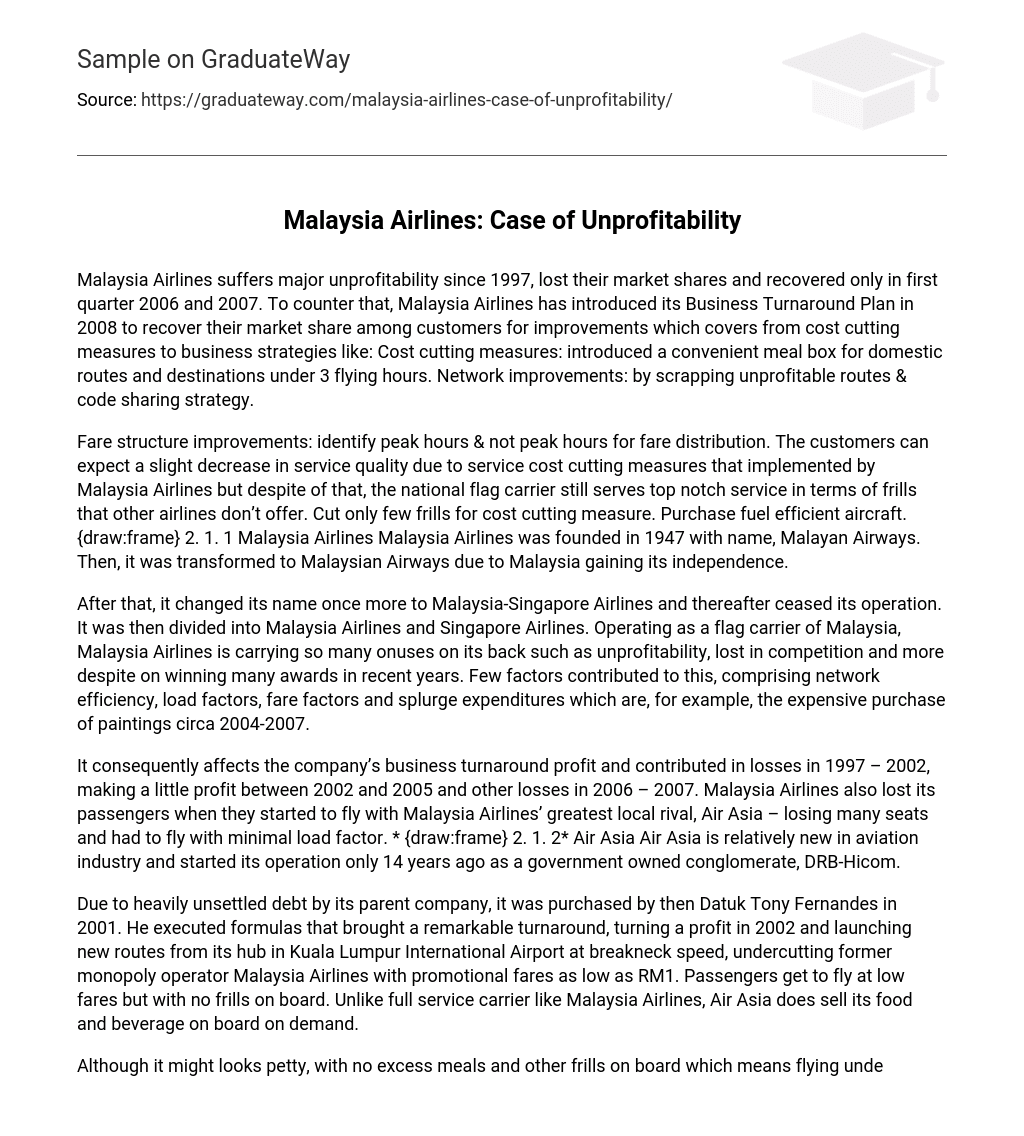Malaysia Airlines suffers major unprofitability since 1997, lost their market shares and recovered only in first quarter 2006 and 2007. To counter that, Malaysia Airlines has introduced its Business Turnaround Plan in 2008 to recover their market share among customers for improvements which covers from cost cutting measures to business strategies like: Cost cutting measures: introduced a convenient meal box for domestic routes and destinations under 3 flying hours. Network improvements: by scrapping unprofitable routes & code sharing strategy.
Fare structure improvements: identify peak hours & not peak hours for fare distribution. The customers can expect a slight decrease in service quality due to service cost cutting measures that implemented by Malaysia Airlines but despite of that, the national flag carrier still serves top notch service in terms of frills that other airlines don’t offer. Cut only few frills for cost cutting measure. Purchase fuel efficient aircraft. {draw:frame} 2. 1. 1 Malaysia Airlines Malaysia Airlines was founded in 1947 with name, Malayan Airways. Then, it was transformed to Malaysian Airways due to Malaysia gaining its independence.
After that, it changed its name once more to Malaysia-Singapore Airlines and thereafter ceased its operation. It was then divided into Malaysia Airlines and Singapore Airlines. Operating as a flag carrier of Malaysia, Malaysia Airlines is carrying so many onuses on its back such as unprofitability, lost in competition and more despite on winning many awards in recent years. Few factors contributed to this, comprising network efficiency, load factors, fare factors and splurge expenditures which are, for example, the expensive purchase of paintings circa 2004-2007.
It consequently affects the company’s business turnaround profit and contributed in losses in 1997 – 2002, making a little profit between 2002 and 2005 and other losses in 2006 – 2007. Malaysia Airlines also lost its passengers when they started to fly with Malaysia Airlines’ greatest local rival, Air Asia – losing many seats and had to fly with minimal load factor. * {draw:frame} 2. 1. 2* Air Asia Air Asia is relatively new in aviation industry and started its operation only 14 years ago as a government owned conglomerate, DRB-Hicom.
Due to heavily unsettled debt by its parent company, it was purchased by then Datuk Tony Fernandes in 2001. He executed formulas that brought a remarkable turnaround, turning a profit in 2002 and launching new routes from its hub in Kuala Lumpur International Airport at breakneck speed, undercutting former monopoly operator Malaysia Airlines with promotional fares as low as RM1. Passengers get to fly at low fares but with no frills on board. Unlike full service carrier like Malaysia Airlines, Air Asia does sell its food and beverage on board on demand.
Although it might looks petty, with no excess meals and other frills on board which means flying underweight, does make a difference in term of fuel burnt and efficiency. The airline is aggressive in winning heart of its passengers by lowering the fares way lower than Malaysia Airlines fares thus making Air Asia win in market share. However, even though the airline is undoubtedly famous with its low fares, they still have outstanding debts with the airport operator, Malaysia Airport Berhad (MAB) making it further questionable, how they are still able to make profit with such business strategy model.
Air Asia is a low cost airline now flying to destinations that Malaysia Airlines flies even international routes. Exhibit 3 (a) Malaysia Airlines suffered few episodes of unprofitability started since 1997 until 2002, brief turnaround profit from 2002 till 2005 and the worst in Malaysia Airlines’ history, major unprofitability in 2005. In my recent research and findings, I found few factors contributed to this which is: 3. 1 Funds leakage to petty things 3. 2 Rising factor cost 3. 3 Low Cost Carrier competition 3. 4 Unprofitable routes {draw:frame}
Based on the newspaper excerpt above, we can conclude that the Malaysia Airlines had spent RM1. 14 million on paintings that are less important during its unstable position, making it losing more than they could imagine. This kind of expenditure portrays on how inefficient and bad management they were having. Referring to Exhibit 3 (a), it shows that Malaysia Airlines suffering its major unprofitability, the worst in the airline’s history RM1. 3 billion. Poor funds management like this contributes to the unprofitability apart from other factors like fuel. {draw:frame} {draw:frame} {draw:frame}
As any airline having problem with their primary mover factor, fuel, Malaysia Airlines also does. During the 2000s energy crisis, crude oil price reached as much as USD50 per barrel compared to about USD40 in 2004. This constraint has forced the airline to impose fuel surcharge to its passengers to cover the loss that the airline is making. {draw:frame} The airline had to impose the fuel surcharge following moves from other airlines and they can’t just ignore the alarming high price fuel. It was said that they will remove the surcharge when the price sustained but to date, the fuel surcharge still lingers in their fare structure.
This is contrary to Air Asia’s fare structure in which they have scrapped the fuel surcharge. 3. 3 Low Cost Carrier Competition Air Asia’s tagline ‘Now Everyone Can Fly’ is really attracting to some people. With attractive fares but with no frills, Air Asia is one of Asia’s favorite low cost carriers and it flies to destinations that Malaysia Airlines flies to. Due to that, it gives our national flag carrier stiff competition considering that they now have Air Asia X which is for international destinations. {draw:frame}





